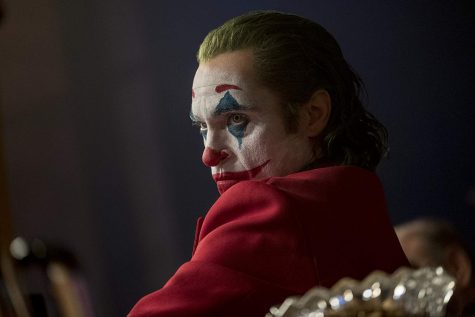A stellar performance amidst a lack of substance
Phoenix steals the show but film hardly touches on any other themes that it tries to present
October 9, 2019
Major spoilers for “Joker” Ahead
In the opening scene of “Joker,” the cruelty of the world that Arthur Fleck (Joaquin Phoenix) lives in is immediately evident: the streets are filled with trash, the buildings are dilapidated and violence is widespread.
While working as a street clown, Fleck almost immediately gets beaten and robbed by a group of kids. While he lays on the ground in pain we are welcomed to the world of the Joker.
The decay of Gotham City provides a grim backdrop for Fleck’s descent into villainy, however, doesn’t offer greater substance than a superficial nudge at the economic and politic issues that riddle the city.
In the film, Phoenix puts on a convincing and eerie portrayal of the classic villain. Ultimately, though, “Joker” falls short in its portrayal of complex social issues.

Joaquin Phoeniz starring in Joker, directed by Todd Phillips
This is due to an underlying sense that the economic suffering endured by the Joker is a catalyst of and justification for evil doing.
Fleck is left without therapy after the city cuts the budget for mental health programs, leaving the audience brutally aware that nobody cares about people who suffer like him.
While the funding cuts are a plot device, there is never any push to really promote how mental health services can help a person. Even when Fleck is going to therapy he reiterates how no one can understand him or his suffering.
This economic suffering is only further exasperated when billionaire and father of Batman, Thomas Wayne, goes on television and insults the lower class while also saying how he knows the solution to their problems.
This leads to mass outrage and protests across the city, as it is once again clear that the world the Joker inhabits simply does not understand the plight of the impoverished.
While the wealth gap is a provocative and relevant issue today, the Joker’s solution proves to be where the film loses touch with its message.
Later in the film, Fleck, while on a subway, observes three employees of Thomas Wayne harassing a woman and responds by shooting the men.
The media reports the murders as a planned attack against the wealthy, which spawns social unrest throughout the city.
The Joker himself never demonstrated that this was his intention, which ultimately makes it seem like the message of the film was forced to become a display of his psyche breaking down.
The missed opportunity to create a meaningful and lasting impression on the audience is further evident in one of the last scenes, when the Joker appears on a talk show.
While it seems like the Joker is psychotic and about to attempt suicide on live camera, the events that transpire subvert this expectation when he instead shoots the talkshow host.
The Joker’s murder of the host could have been used as an opportunity to scorn the economic system that had oppressed him for so long.
Instead, it simply cuts to the next scene of him out among rioters once again being ambivalent to the world around him.
The lack of action, and the chain of the Joker’s massacres, turn what could have been an easy character to sympathize with into a psychotic maniac.
The portrayal of the Joker by Pheonix, while a brilliant portrayal of a demented man, fails to use its platform to be an advocate for those who are impoverished — and, ultimately, loses sight of its power to affect change.

























































































